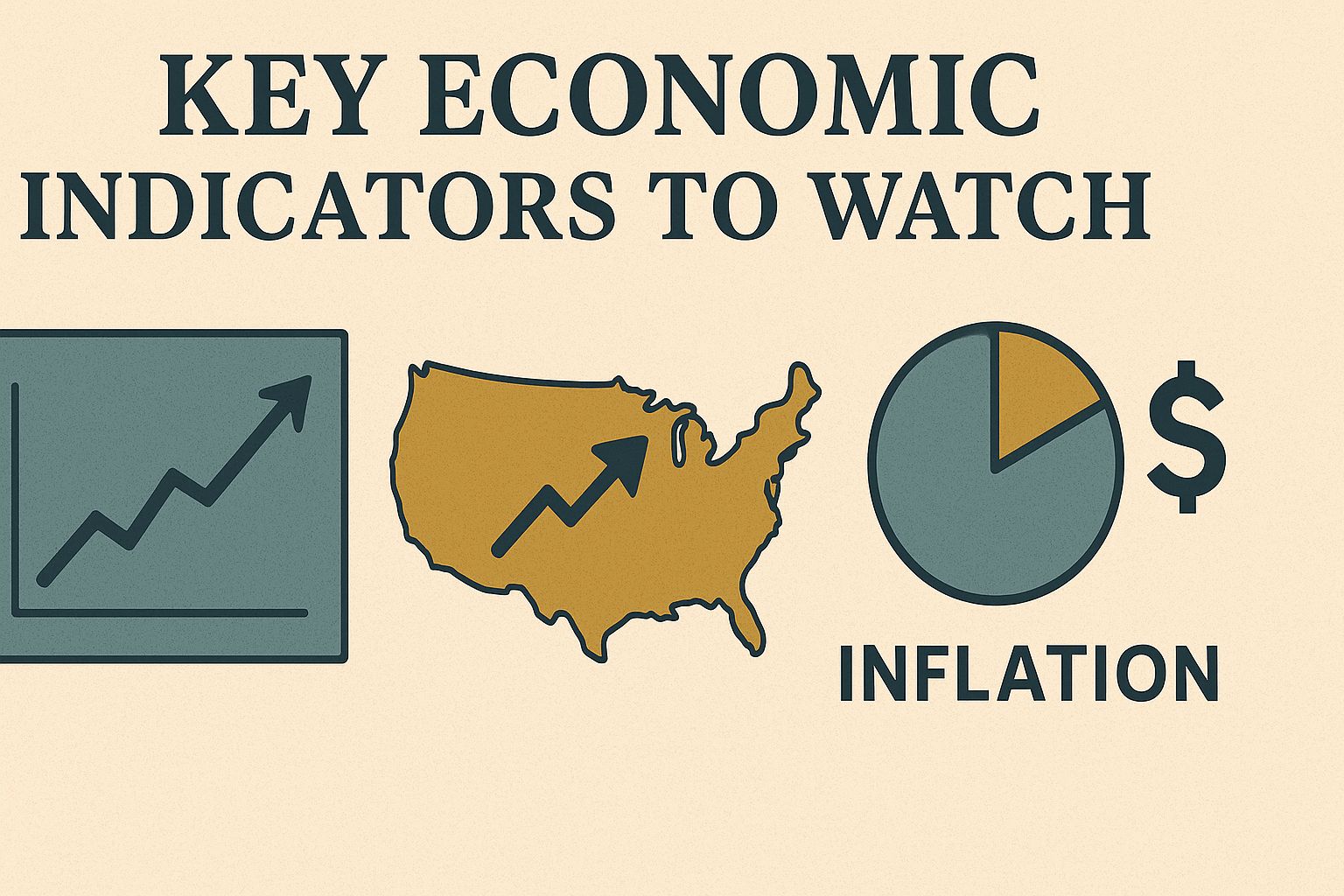Your cart is currently empty!
Key Economic Indicators to Watch

Key economic indicators drive financial markets and inform policymakers, businesses, and individual investors. Whether you live in the US, UK, Italy, or elsewhere in Europe, knowing how to interpret signals such as inflation, GDP, and Federal Reserve policy can help you make smarter financial decisions. In this guide, you will learn why these measures matter, how they interact, and where you can find reliable data. Along the way, you will discover practical applications—from navigating market turbulence to planning for a home purchase.
Inflation as a Key Economic Indicator
Inflation reflects the rate at which prices for goods and services rise over time. Central banks, economists, and consumers watch inflation closely because it directly impacts purchasing power. For instance, when inflation accelerates, each unit of currency buys fewer goods, eroding real incomes. Consequently, savers see the real value of their cash balances decline, while borrowers may benefit from repaying loans with devalued money.
Analysts typically measure inflation through indices like the Consumer Price Index (CPI) and the Producer Price Index (PPI). CPI tracks a basket of consumer goods and services, whereas PPI captures price changes from the producer’s perspective. When either index climbs rapidly, central banks may respond with tighter monetary policy to cool demand. However, persistent low inflation—or even deflation—can signal weak demand and economic stagnation.
Moreover, inflation affects creditworthiness and personal finance. Rising prices can strain budgets, pushing individuals to rely more heavily on credit. To counteract this trend, it helps to maintain a strong credit profile. For strategies on improving your score and managing debt, see our guide on Credit Repair and Financial Coaching.
GDP Growth: Measuring Economic Output
Gross Domestic Product (GDP) represents the total value of all goods and services produced within a country over a specific period. As a primary gauge of economic health, GDP indicates whether an economy is expanding or contracting. When GDP growth is strong, businesses tend to hire more workers, consumers spend freely, and corporate earnings generally rise. Conversely, slowing GDP growth often precedes higher unemployment and lower market valuations.
Economists distinguish between nominal GDP and real GDP. Nominal GDP measures output at current prices, while real GDP adjusts for inflation, offering a clearer view of true economic expansion. Tracking real GDP growth helps you understand whether increases in output stem from higher prices or real gains in production.
Understanding GDP trends can also guide your long-term financial planning. For example, if GDP growth slows in your region, housing markets may soften. If you’re saving for a home, you can benefit from lower prices or negotiate more favorable terms. To explore strategies for navigating today’s housing market, refer to The Ultimate Guide to Saving for a Home in the Current Housing Market.
Federal Reserve Policy and Interest Rates
The Federal Reserve (the Fed) sets monetary policy in the United States, influencing interest rates, credit availability, and ultimately economic growth. When the Fed raises its benchmark rate, borrowing costs for mortgages, auto loans, and business credit increase. Higher rates typically slow consumer spending and business investment, thereby cooling inflation. On the other hand, rate cuts aim to stimulate the economy by making credit cheaper, encouraging spending and investment.
Financial markets react swiftly to Fed announcements. Equity prices may tumble if investors fear a rate hike will weaken corporate profits. Bond yields often rise in anticipation of higher rates. Therefore, staying informed about Fed outlooks and meeting minutes is crucial. You can learn how to adjust your portfolio to shifting monetary policy in our article on Navigating Market Volatility in a High-Interest-Rate Environment.
Other Key Economic Indicators in Context
Beyond inflation, GDP, and interest rates, several supplementary measures offer insight into economic momentum. The unemployment rate reveals labor market health, while consumer confidence surveys gauge spending intentions. Industrial production data highlights manufacturing trends, and retail sales figures signal consumer demand. Although no single indicator provides a complete picture, together they form a mosaic that helps analysts forecast economic cycles.
For investors, correlating these indicators with individual company performance can uncover opportunities. For example, if manufacturing output strengthens, industrial and technology firms may report higher earnings. To see how broader economic shifts have impacted a leading data analytics company, explore our Palantir Stock: A Deep Dive into Its Growth Performance.
How to Monitor Key Economic Indicators
Accessing timely and accurate data is the first step toward informed decision-making. In the US, the Bureau of Labor Statistics publishes monthly inflation and employment reports. The Bureau of Economic Analysis releases quarterly GDP figures. Meanwhile, the Federal Reserve’s website provides meeting schedules, minutes, and speeches by Fed officials. In Europe, similar data comes from Eurostat, the Office for National Statistics (UK), and national statistical offices in Italy and other EU countries.
You can also use financial news outlets and economic calendars offered by brokerage platforms to track release dates. When the data arrives, analyze how it diverges from market expectations. If inflation exceeds forecasts, bond prices may fall. If GDP growth surprises to the upside, equity markets often rally. By incorporating these releases into your routine—perhaps by setting calendar alerts—you stay a step ahead of market moves.
Applying Economic Insights to Personal Finances
Economic trends should inform your budgeting, saving, and spending decisions. When inflation picks up, you may want to allocate more funds toward inflation-protected assets or negotiate fixed-rate loans. Conversely, in a low-growth environment, focusing on essential expenses and building an emergency fund can shield you from market shocks.
Generation Z, in particular, faces unique challenges as they enter the workforce amid volatile markets. To develop sound spending habits and maintain financial resilience, explore our Budgeting 101 for Gen Z guide. Additionally, economic downturns create opportunities to strengthen your financial foundation. To discover tactics for safeguarding your wealth during recessions, see Recession-Proofing Your Personal Finances: 5 Essential Strategies.
Planning for the Future: Estate and Asset Protection
While macroeconomic indicators guide everyday financial choices, they also underscore the importance of long-term planning. Economic shifts can affect the value of digital assets, retirement accounts, and inheritances. To ensure your loved ones are protected, you should establish clear directives and legal frameworks that reflect current asset valuations and anticipated market trends.
If you hold cryptocurrency, digital art, or other digital assets, familiarize yourself with best practices for legacy planning. Our Estate Planning for Digital Assets article outlines steps to secure your digital legacy and provide instructions for trustees or executors. Effective estate planning preserves wealth through economic cycles and offers peace of mind.
Conclusion: Empowered by Key Economic Indicators
In a complex global economy, no single data point tells the whole story. Still, inflation rates, GDP growth, and Federal Reserve decisions form the backbone of economic analysis. By monitoring these key economic indicators, you gain insight into market direction and can adapt your financial strategy—whether you’re investing in technology stocks, buying a new home, or building a safety net.
Remember to leverage reputable sources and trusted commentary. Combining quantitative data with qualitative analysis—such as corporate earnings calls and geopolitical developments—will deepen your understanding. As you integrate these insights, you stand better positioned to navigate uncertainty and capitalize on opportunity across the US, UK, Italy, and Europe.

Mr. Rajeev Prakash
Rajeev is a well-known astrologer based in central India who has a deep understanding of both personal and mundane astrology. His team has been closely monitoring the movements of various global financial markets, including equities, precious metals, currency pairs, yields, and treasury bonds.
Featured Post
Financial Astrology Terminal
The Financial Astrology Terminal is a web platform that combines real-time U.S. market data (S&P 500, Nasdaq, Dow, Russell, key stocks and commodities like gold and silver) with planetary cycles, giving traders and investors astro-timing signals on top of normal charts and analysis.
